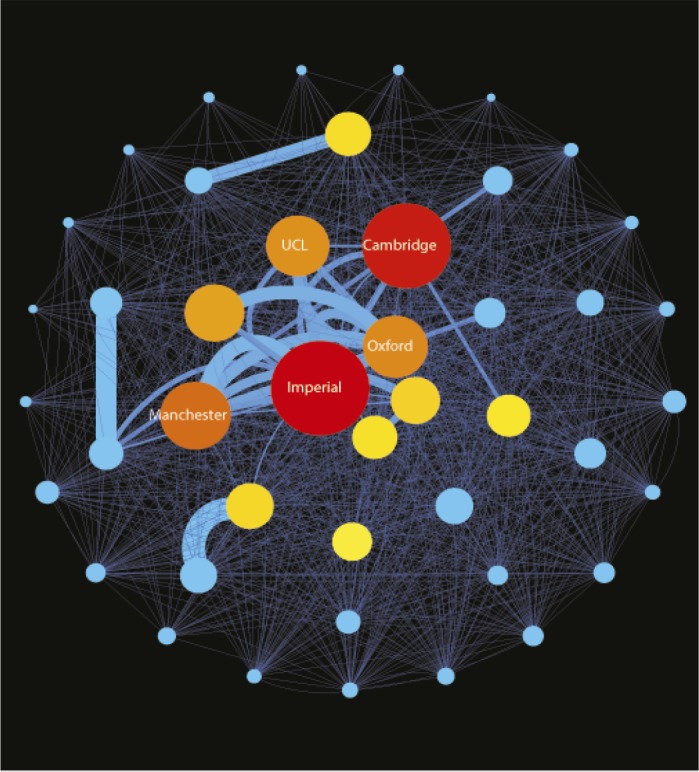Networks of research funding success

Collaborations funded by the Engineering and Physical Sciences Research Council between 1985 and 2013.
Previous studies have examined the collaborative nature of academic research, but few studies have investigated the role of research funding in scientific collaborations. To trace the role of funding in academia over time, Athen Ma et al. (pp. 14760–14765) examined more than 43,000 projects funded by the United Kingdom’s Engineering and Physical Sciences Research Council between 1985 and 2013. The authors observed a general increase in overall research funding and an overall decline in total grants awarded over the study period, suggesting a trend toward a small number of large awards. At the institutional level, the authors found inequality in the award of research funding, with a substantial share of the awards going to prestigious universities. The leading universities also produced a high degree of variety and quality in research output, according to the authors. The study suggests that the leading universities, linked by cohesive collaboration networks, can serve as knowledge brokers, occupying advantageous positions to identify and pursue research opportunities. The results further suggest that studying the elements of success in leading universities’ funding efforts may assist other institutions in increasing research funding, according to the authors. — P.G.
Declining lion populations in Africa

Cecil the lion. Image courtesy of Andrew J. Loveridge (University of Oxford, Oxford).
Regional-scale changes in lion populations over time are difficult to estimate, due to lack of reliable data from many countries and inconsistent repetition of surveys. Hans Bauer et al. (pp. 14894–14899) compiled credible repeated surveys of lion populations since 1990, covering 47 lion populations, and used a statistical method to estimate the growth rate of each population. The data revealed not only sharp declines in nearly all lion populations in West Central Africa, but also that the region as a whole was likely to lose half of its lions over the next two decades. Populations in East Africa also declined, and the authors estimated a 37% likelihood that East Africa will lose at least half of its lions over the next two decades. In the southern African countries of Botswana, Namibia, South Africa, and Zimbabwe, where most lion populations are in fenced reserves, populations appeared to be increasing, suggesting the importance of well-funded, intensely managed reserves for maintaining lion populations. The authors suggest that these results support designating lions as regionally critically endangered in West Africa and regionally endangered in East Africa. The rapid disappearance of lions in many parts of Africa suggests a major ecological shift, with lions no longer playing the role of apex predator, according to the authors. — B.D.
Circadian clock misalignment and its consequences

Circadian clock misalignment and metabolism. Image courtesy of iStockphoto/alptraum.
Shifting the feeding of mice from active nighttime hours to resting daytime hours shifts the expression of components of peripheral circadian clock (PCC) systems, but the mechanism of the shift is unknown. Atish Mukherji et al. (pp. E6683–E6690) measured metabolic indicators in mice that had experienced a shift in their feeding schedules from night to day. The mice quickly experienced low blood insulin during the active phase, which triggered increases in levels of free fatty acids and the hormone glucagon. These elevated levels further activated selective metabolic receptors that led to metabolic changes during the active phase, including untimely overexpression of the PCC-component protein RevErbα, which altered the timing of expression of PCC genes and consequently led to a shift of PCC systems by 12 hours. In a related article, Atish Mukherji et al. (pp. E6691–E6698) explored why the master circadian clock does not experience the same shift as the PCC when feeding schedule is shifted. The authors found that PPARα and glucagon receptors, both instrumental in the chain of metabolic events leading to PCC shift, are not expressed in the master circadian clock, which is located in the brain’s suprachiasmatic nucleus and is entrained by light. The authors report that because the master clock normally coordinates gene expression and homeostasis in the PCC systems, misalignment between the master clock and PCCs disrupts the activity of the homeostatic genes and leads to metabolic syndrome. The results demonstrate molecular mechanisms by which biological clocks in the periphery can be disrupted and suggest the pathological consequences of misalignments between the master light-entrained clock and peripheral clocks, according to the authors. — P.G.
Predicting autism outcomes
Although behavioral assessments in people with autism can explain some of the variation in outcomes and function, much of the variation remains unexplained. To evaluate predictors of outcome in addition to age and behavioral traits, Mark Plitt et al. (pp. E6699–E6706) measured resting-state functional connectivity in the brains of 31 males with autism, who were on average around 18 years old, via MRI, and followed up with assessments of adaptive behavior and autistic traits at least 1 year after scanning. The authors found that 44% of the study group experienced a significant change in scores on adaptive behavior between the initial scan and follow-up. Connectivity between three resting-state networks, including the salience network, the default-mode network, and the frontoparietal task control network, was linked not only to future autistic behaviors, but also to changes in autistic and adaptive behaviors over the postscan period. Further, connectivity involving the salience network and associated brain regions was associated with improvement in adaptive behaviors, with 100% sensitivity and around 71% specificity. The results suggest a method to account for variation in outcomes unaccounted for by other measures, and may also hint at brain networks involved in autistic behaviors and symptom abatement, according to the authors. — P.G.


